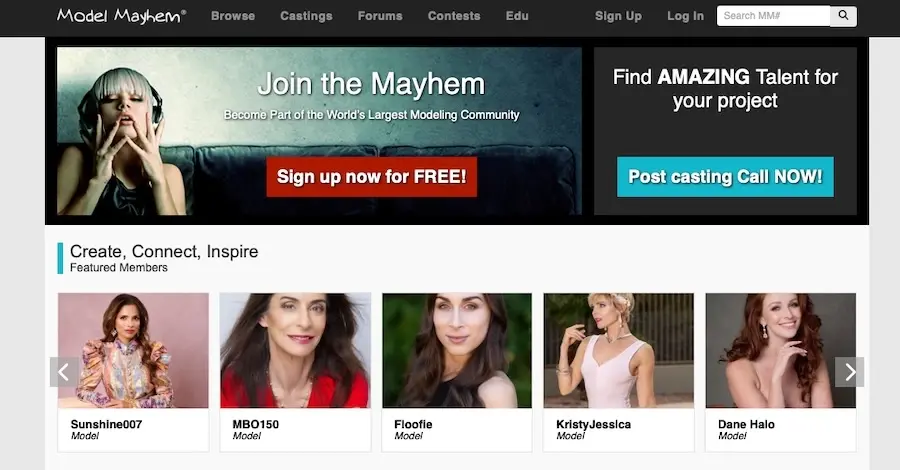Have you ever pictured yourself in front of a camera, showcasing the latest fashion trends or being the face of a new product? Becoming a freelance model might be the career for you!
But unlike traditional modeling routes that often require an agency's backing, freelance modeling offers a path filled with flexibility and personal empowerment. It's a career that not only tests your dedication but also rewards you with unique experiences and the freedom to choose your own gigs.
In this guide, we'll navigate the ins and outs of becoming a freelance model, from building your portfolio to landing your dream gigs. Whether you're just curious about the industry or ready to dive in headfirst, this article is your “runway” to start.
How the Freelance Modeling Industry Works

Freelance modeling is about more than just looking good in photos. It's a dynamic field that requires a mix of talent, business savvy, and self-marketing. Unlike agency models, freelance models manage their own careers. This means finding your own gigs, negotiating contracts, and often doing your own marketing. It's challenging, but it's also incredibly rewarding for those who crave independence and control over their career paths.
The Freelance vs. Agency Model
To better understand, let’s take a look at these two career approaches side-by-side.
Autonomy: Freelance models have the freedom to choose the projects they work on and the clients they work with. This autonomy can lead to a more varied and exciting portfolio.
Direct Client Relationships: Without an agency as an intermediary, freelance models often work directly with clients, which can lead to more personal connections and repeat collaborations.
Greater Earning Potential: While agencies take a percentage of your earnings, as a freelancer, you keep what you make, minus your expenses.
Key Opportunities in Freelance Modeling
The freelance modeling world is diverse, including everything from fashion and runway modeling to commercial and lifestyle shoots.
Social media and online platforms have opened up new avenues for freelance models to showcase their work and connect with potential clients. Instagram, in particular, has become a portfolio platform, allowing models to gain visibility and attract opportunities.
However, this path requires resilience and adaptability. You have to stay informed about industry trends and continuously develop your skills.
Building Your Modeling Portfolio

A compelling portfolio is your ticket to success in the freelance modeling industry. It's not only a collection of your best work but also a representation of your range and versatility.
Crafting a Standout Portfolio
Your portfolio should include a range of styles and formats. Think high-fashion shoots, commercial looks, lifestyle images, and more. This diversity shows potential clients your adaptability.
Then, select high-resolution, professionally-taken photographs. A portfolio with a few strong images is better than one filled with average shots.
You should also be sure to keep your portfolio fresh with new images that reflect your current look and skills.
Collaborating for Success
Work with multiple photographers to bring a unique style to your portfolio. A varied portfolio can serve you well but also niching down has its advantages, too. It all comes down to what you’d like to accomplish.
Trade for Print (TFP) shoots are a great way to build your portfolio when starting out. You provide your modeling services in exchange for professional photographs. It’s worth considering if you have no photos yet.
Going Digital
Having an online portfolio is essential. Platforms like Instagram can serve as a dynamic portfolio, showcasing your work to a broader audience.
Consider creating a personal website with a professional portfolio, biography, and contact information as well though, as this won’t be beholden to the rules of a social media platform. Doing so can also add credibility and professionalism to your brand. You can do this by building a WordPress website. Many portfolio themes are available to cut down the design process, many of which are free. You will need to purchase hosting, however. Verpex Hosting offers robust hosting plans for WordPress for just a few dollars per month – domain name included.
Building a strong portfolio is an ongoing process. It's about capturing and showcasing your evolution as a model.
Developing Your Personal Brand
Your personal brand is what sets you apart as a model. It's a mix of your image, personality, and the unique qualities you bring to the table.
Here are some tips for developing your brand effectively.
Craft Your Image
First thing’s first, you need to develop an image – something that’s undeniably “you.” A few ways you can do this include:
Identify Your Unique Traits: What makes you unique as a model? Is it your style, attitude, or a particular look? Highlight these traits in your portfolio and marketing materials.
Maintain Consistency Across Platforms: Maintain a consistent image and style across all platforms, from your social media profiles to your portfolio. This helps in building a recognizable and memorable brand.
Engage Authentically: Authentic engagement with your audience builds trust and loyalty. Share your journey, challenges, and successes to connect with your followers on a personal level.
Network Effectively
To build a brand, you also need to “get out there,” so to speak. That is, make yourself known in the industry.
You can attend fashion shows, workshops, and industry gatherings to build a network. These events are opportunities to meet industry professionals and other models.
Collaborating with photographers, makeup artists, and fashion designers is another way to build up the list of who you know. These collaborations can lead to exposure and new opportunities.
Build a Positive Reputation
Demonstrating a solid work ethic can go a long way toward building a positive reputation for your modeling work. Be professional, punctual, and prepared for every job. Your reputation in the industry is crucial.
Also, seek feedback from industry professionals and be open to constructive criticism. Continuous improvement is key to long-term success.
Finding Modeling Gigs

Landing gigs is one of the hardest parts of being a freelance model. It requires a proactive approach and smart strategies. Here are a few tips for landing more gigs:
Leverage Your Network: Use your contacts for job referrals. Keep in touch with photographers, stylists, and other models you've worked with.
Use Online Platforms: Use modeling platforms like Model Mayhem or industry-specific job boards. Ensure your profiles are updated and showcase your best work.
Direct Outreach: Research and reach out to brands or photographers whose work aligns with your style. A well-crafted email or direct message can be effective.
Use Social Media as a Tool
Regular posts showcasing your work can attract the attention of potential clients. Use relevant hashtags to increase your reach.
You can also engage with brands you're interested in on social media. Comment on their posts and share your relevant work.
Navigating Contracts and Negotiations
Familiarize yourself with the basics of modeling contracts. Know what to look for and what to avoid.
And don't be afraid to negotiate your rates and terms. Know your worth and be prepared to discuss it confidently.
Maintaining a Successful Freelance Modeling Career
Sustaining a successful freelance modeling career requires more than just finding initial success. You need to put in the work to maintain it.
Here are several things you can do to ensure your modeling career grows with you over the long term.
Stay updated with the latest trends in fashion and modeling.
Attend workshops and courses to enhance your skills and knowledge.
Keep a close eye on your finances by tracking your income, managing your expenses, and planning for slow periods.
Balance your professional commitments with personal well-being by taking time for self-care and to recharge.
Maintain a healthy lifestyle, including regular exercise and a balanced diet.
Pay attention to your mental and emotional health, as the freelance lifestyle can be demanding.
The modeling industry is constantly evolving so being open to new types of modeling jobs and changing market demands can keep you relevant.
Be creative in finding new ways to market yourself. This could mean exploring different styles of modeling or branching into related fields like acting or influencer work.
Build strong relationships with clients. Repeat business and referrals are significant in sustaining your career.
A successful freelance modeling career is a blend of talent, hard work, and smart strategy. Stay dedicated, be adaptable, and always look for ways to grow and improve.
Make Your Dream to be a Freelance Model a Reality
Setting out to start a freelance modeling career is an adventure filled with opportunity. From crafting a compelling portfolio to developing your personal brand and finding gigs, every step is a building block towards success.
Remember, the key to a flourishing career is not just in landing jobs, but in continuously evolving, staying true to yourself, and keeping your name out there. A good portfolio can do a lot of the heavy lifting for you, so investing in solid web hosting is a great place to start.
Now, put in the hard work and watch as you turn your dreams of becoming a model into reality.
Frequently Asked Questions
Can I specialize in a specific industry as a freelance data analyst?
Yes, specializing in a particular industry, such as finance, healthcare, or marketing, can be beneficial. It allows you to tailor your skills and insights to meet the specific needs of clients in that industry.
How should I pitch my services and set my rates as a freelancer?
Craft personalized pitches highlighting how your skills align with a client's needs, communicate transparently about your process and set competitive rates based on industry research and the complexity of the project.
What are the best tools for setting up my freelance business online?
For building a professional website, consider using web hosting services like Verpex Hosting for reliability and ease of use.
What are the best ways to network and market my freelance business?
To grow your freelance business, actively post and engage on platforms like LinkedIn, attend industry conferences and networking events, share valuable content related to your field, and encourage satisfied clients to refer you to others. To further develop your skills, enrol in online courses, stay updated with industry trends and technologies, learn from other professionals in your field, and seek client feedback to improve your services.

Brenda Barron is a freelance writer and editor living in southern California. With over a decade of experience crafting prose for businesses of all sizes, she has a solid understanding of what it takes to capture a reader's attention.
View all posts by Brenda Barron




















